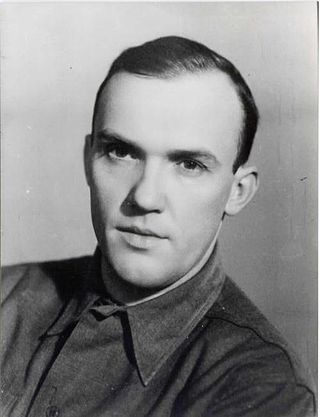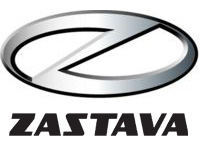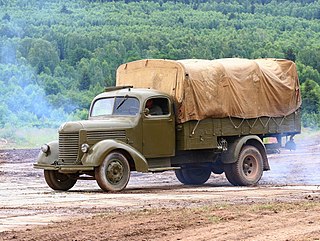
Tomos was a Slovene moped manufacturer based in Koper. It was founded in 1948. Tomos acquired a production license from Puch to produce moped models under the Tomos name in 1954. Tomos had since produced various goods for the Eastern European market, including motorcycles, mopeds, outboard motors and Citroën cars for the home market.

DAC, an initialism for Diesel Auto Camion, is a Romanian commercial vehicle brand produced since 1971 in the Brașov area. The DAC brand served as a reminder of the Romania’s history, the historic region of Dacia, once home to the ancient dacian tribes.

Avia Motors s.r.o. is a Czech automotive manufacturer. Founded in 1919 as an aircraft maker, it diversified into trucks after 1945. As an aircraft maker it was notable for producing biplane fighter aircraft, especially the B-534. Avia ceased aircraft production in 1963.

Zastava Trucks is a Serbian truck manufacturer based in the city of Kragujevac, Serbia. It is a subsidiary of Group Zastava Vehicles which declared bankruptcy in May 2017. In September 2017, the Government of Serbia established Zastava TERVO, which took over Zastava Trucks production facilities.
Korporacija Fabrika automobila Priboj is a Serbian automotive manufacturer of military vehicles and with the headquarters in Priboj.

Praga is a manufacturing company based in Prague, Czech Republic. The company produced motorcycles, automobiles, trucks and airplanes. The Praga V3S 5-ton truck was used by the Czechoslovak Army for more than half a century. The current company produces karts, racing and road supersports and is involved in car racing. It produces up to 7,000 kart chassis every year, making it one of the most successful kart manufacturers in the world.
Ikarbus a.d. is a Serbian bus manufacturer based in Zemun, Belgrade.

Matej Bor was the pen name of Vladimir Pavšič, who was a Slovene poet, translator, playwright, journalist and Partisan.

FAP 2026 is a general purpose off-road lorry made by Serbian vehicle manufacturer Fabrika automobila Priboj (FAP). The six-wheel drive lorry is designed for transport of personnel, weapons and material up to 6 t of total weight, as for traction of weapons and trailer up to 7.2 t of weight for the needs of the Yugoslav People's Army.

The Slovenian Ground Force is the primary component of Slovenian Armed Forces.

The Territorial Defense of the Republic of Slovenia, also known as the Territorial Defense of Slovenia, was the predecessor of the Slovenian Armed Forces. It was named after the Yugoslav Territorial Defense.
Neobus a.d. was a Serbian bus manufacturer which went bankrupt in 2012. The major shareholder from 2004 was a Saudi businessman Alaa Maghrabi Mohammedali A. Neobus produced buses on its original chassis and on the chassis of other manufacturers such as Volvo, DAF Bus, Mercedes-Benz, FAP.

Zastava Automobiles was a Serbian international car manufacturer, a subsidiary of Group Zastava Vehicles which went bankrupt in May 2017.
Serbia's automotive industry is one of the most important industrial sectors and makes about 15% of industrial output of the country and 18% of all exports.

TAM 110 T7 B/BV is a general purpose off-road lorry made by Yugoslav vehicle manufacturer Tovarna avtomobilov Maribor (TAM). The four-wheel drive lorry is designed for transport of personnel, weapons and material as for traction of weapons and trailer up to 2.5 tons of weight for the needs of the Yugoslav People's Army.

The TAM 150 T11 B/BV is a general-purpose off-road lorry made by Slovenian vehicle manufacturer Tovarna avtomobilov Maribor (TAM). The six-wheel-drive lorry was designed for use by the Yugoslav People's Army, in the transport of personnel, weapons, and materials.

The Praga RN was a medium-sized truck manufactured by Praga from 1933. The vehicle was powered by a six-cylinder petrol engine. From 1934, the diesel-powered version Praga RND was also manufactured. The trucks were manufactured for nearly three decades and became one of the most widely used freight wagons in Czechoslovakia, the chassis being used for buses and fire engines as well as for military uses. RN production ended in 1953 and RND in 1955, although production continued in Yugoslavia until 1962. In total, around 40,000 Praga RN and RND were produced, including about 3,700 buses, as well as 18,300 RN license built in Yugoslavia.
The moving of the Serbian industry to western Yugoslav republics was a strategy of the government of the Federal People's Republic of Yugoslavia to conduct massive transfer of industrial plants, machinery, technology and experts from PR Serbia to the western republics of Yugoslavia during the Informbiro period (1948—52) and shortly after it. In some cases, only parts of industrial plants were moved while in others the whole factories were dismounted and transported out of Serbia. Since the ratio of highly educated people was very low at that time, moving experts out of Serbia had substantial negative consequences for its future development.























